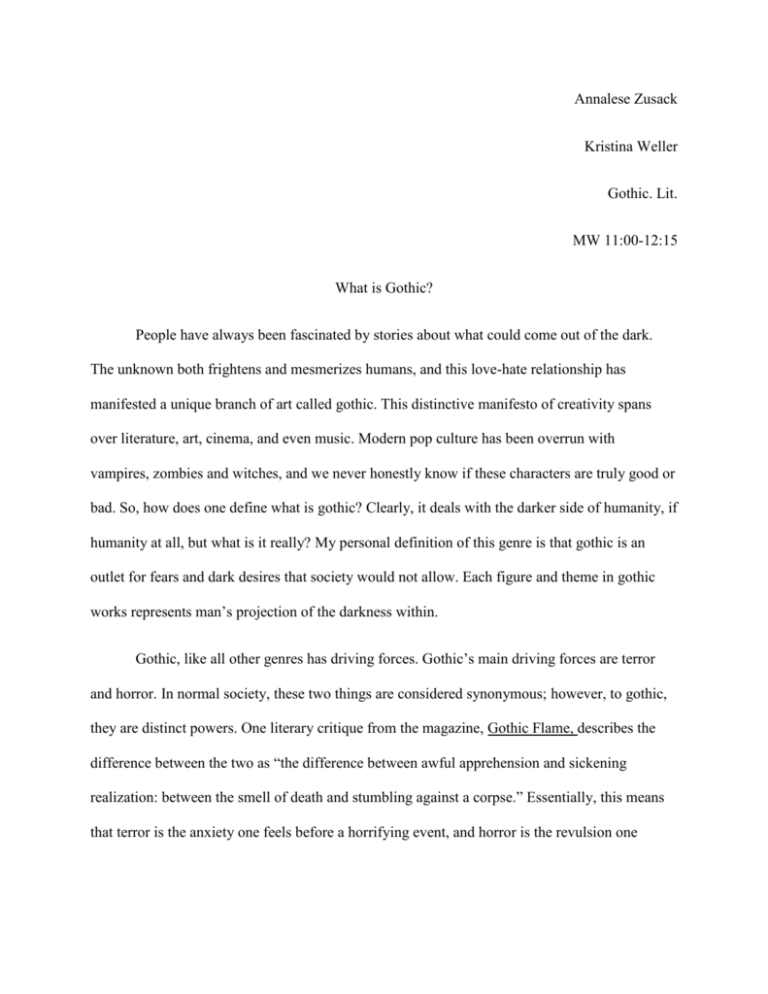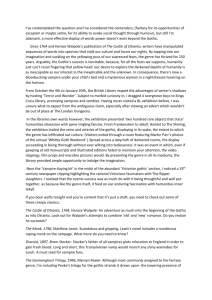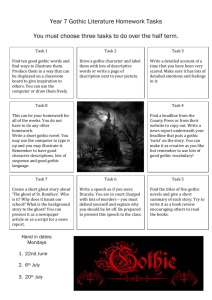gothic beautiful
advertisement

Annalese Zusack Kristina Weller Gothic. Lit. MW 11:00-12:15 What is Gothic? People have always been fascinated by stories about what could come out of the dark. The unknown both frightens and mesmerizes humans, and this love-hate relationship has manifested a unique branch of art called gothic. This distinctive manifesto of creativity spans over literature, art, cinema, and even music. Modern pop culture has been overrun with vampires, zombies and witches, and we never honestly know if these characters are truly good or bad. So, how does one define what is gothic? Clearly, it deals with the darker side of humanity, if humanity at all, but what is it really? My personal definition of this genre is that gothic is an outlet for fears and dark desires that society would not allow. Each figure and theme in gothic works represents man’s projection of the darkness within. Gothic, like all other genres has driving forces. Gothic’s main driving forces are terror and horror. In normal society, these two things are considered synonymous; however, to gothic, they are distinct powers. One literary critique from the magazine, Gothic Flame, describes the difference between the two as “the difference between awful apprehension and sickening realization: between the smell of death and stumbling against a corpse.” Essentially, this means that terror is the anxiety one feels before a horrifying event, and horror is the revulsion one experiences after the event. Both of these forces play essential roles in creating the essence of gothic. Where terror is the darkening of the clouds, horror is the destruction after the squall. Sigmund Freud suggests that the reason things are considered horrifying, such as reanimation of the dead, is our long standing origins of witchcraft based beliefs and the psychological connection humans make between darkness, solitude, and silence. The feeling of horror one experiences stem from those factors. The 1861 story, Green Eyes, by Gustave Becquer, demonstrates both forces. The reader is filled with a terror of the mysterious woman whom Fernando meets at the springs when she asks if he would still love her if she was a demon. Then, horror takes over when she lures him to the edge of the pool, and the waters close over his head. Dr. Freud’s analysis and these stories demonstrate the differences of human fear and its influences on gothic literature. One of the other reoccurring themes in gothic is the doppelganger, or the double. This device is seen in many gothic works both film and literature and serves as a window into the soul for critique and a means to overcome death. When the creator seeks to critique the soul, the double usually appears as a reflection in a mirror or as an evil twin. In the film Secret Window inspired by Stephen King’s novel, the main character, played by Johnny Depp, is dissatisfied with his life. His wife has left him for another man, he is experiencing writer’s block, and he is in general suffering from depression. To top everything off, he is also threatened by an unknown man named Shooter. Shooter claims that Depp stole his story, and as recompense, he wants him to fix the ending. Depp seeks help from the police and body guards to no avail. Soon, the bodies begin to pile up, and nobody but Depp has even seen Shooter. Eventually, Depp is confronted with the fact that Shooter is one of his own personalities. In a twist of metafiction, Depp realizes that to fix his ending, he must live it and kill his wife. The Venesian-American psychologist, Otto Rank, continues this theme when he writes that the double was a reaction to man’s fear of death. He argues that the “immortal soul” was probably the first double of the body to ensure that death was not the end of existence. Rank references Egyptian sarcophagi to support this theory: a fact that they would impose the deceised’s likeness on a statue to be used in the afterlife. He also notes that the double is an expression of man’s extreme narcissism to conquer death. Once the mind’s mastery of death has been established, he notes how the route of the double allows man to treat his soul as an object. A perfect example of this appears in the nineteenth century novel The Picture of Dorian Gray. The story tells of a young boy who traps his soul in a portrait of himself. Over time, the painting ages and reflects the abuses he inflicts on his body while his own appearance remains young and pristine. Furthermore, the Vampire is a hallmark figure in gothic as well. Originally, the vampire was a monster but has morphed into sensual specters of the shadows. The vampire, like the double, also represents man’s desire to overcome death, and they also are an icon of forbidden sexual desires. The vampire’s source of power, blood, is representative of the human life source. The vampire’s fangs mark their predatory nature, such as lions, and also refer to Freud’s ideas of oral fixation. The idea of biting is very primitive, aggressive, and, when on the neck, very sensual. Biting is a very animalistic way of fighting, taking people back to their archaic origins when they were almost animals themselves. Biting on the neck is a very personal act between lovers, such as love bites, hickies, or necking. The vampire is thus depicted as the perfect predator, using his charms of seduction to lure his prey in. This kind of fierce sexuality gives a nod to the psychological traits of people who enjoy BDSM (Bondage, Slave and Master). The vampire Lestat, a creation of Anne Rice’s imagination, is a great example of a modern vampire. He is described as a beautiful youth with a highly sensitive disposition, which he uses to lure in his prey. When he feeds, he describes it as very intimate, and to most, it’s almost like a sexual experience: one of his victims actually reached sexual climax during his feeding session. While many vampires are the bad boys of the monster world, others are reformed. Edward Cullen from Twilight acknowledges his predatory nature but seeks moral redemption by abstaining from human blood and only drinking from animals. Despite their differences of ideas, vampires are an outlet for man’s more devious sexual longings. While many of gothic’s themes are about overcoming death, and death itself is a very common theme. The preoccupation with death is tied into the obsession of triumphing above it. It is both feared and loved by many artists. For example, the Author Baudillair describes a corpse as beautiful in his poem “The Empty Flask.” He also mentions the pointlessness of life since one is only to die and can’t ever escape that fate. Another poet, Jose Cadalso, embraces death and considers it a reprieve from the torture of life. In his poem, “Lugubrious Night,” he regales the reader with his staggering grief over his deceased love and his longing for death. One evening, he falls into reverie at her grave, and as the sun sets, he witnesses a white specter darting among the headstones. Therefore, with death on his mind, he runs into the awaiting spirit’s arms. In another kind of expression, the band HIM has created a song called “Join Me in Death,” which tells the story of two lovers who plan to commit suicide together so their love won’t be as fleeting as life. The two will be united eternally in their love because they will have a life after death. All of these works have one common thread, which is perhaps why man is fascinated with death. They all believe that life is almost a disease and that there is a life after death that will be perfect, a kind of heaven. Man has always been frightened by the unknown of death, and thus seeks the possibility of a continuation of self through the immortal soul. The concept of the presence of evil is the overarching theme of gothic. Monsters, murderers, and mayhem are frightening because of their evil and sinister nature; however, those are just progenies of true evil that needs no physical body but has a presence nonetheless. The idea of evil is universal: it plays a part in all religions and cultures and is therefore frightening to all people. This kind of ambiguous evil can be found in the movie 1408 with John Cusack and Samuel L. Jackson. Cusack, a jaded writer who has recently lost his daughter, stays the night in the haunted room 1408 in the Dolphin Hotel. The challenge is to last an hour, but as the seconds tick by, he begins to realize this is no normal room. Strange events occur as he is tormented by all kinds of demons, and he realizes he is in a battle; yet the persecutor is unknown. There is nobody there but him. The sheer presence of evil makes one’s knees shake and even the stout of heart quail. The themes and figures of gothic represent man’s fear of the unknown and are a projection of the darkness within. Gothic can be described as man’s outlet for his fears and dark desires. This genre is both powerfully beautiful and haunting. While morphing with the ages, this need for stimulation of the frightening and alarming is seen in the abundant examples from modern pop culture. Gothic is seen the world over for its universal themes of death, evil, and mayhem, and for its memorable character that linger in the shadows of our imagination long after the story ends.







